double
_L2HysThreshold=0.2,
bool
_histogramNormType=L2Hys,
大家好,由于我的毕业设计是“基于图像的手势识别”,因而对 HOG 算法和 SVM
算法有一定的研究,下面将我的学习心得和论文算法部分和大家分享。计算机视
觉是很有发展潜力的,希望大家共同分享,共同进步。
首先关于 HOG 算法:
#include "_cvaux.h"
/********************************************************************
*********************
struct CV_EXPORTS HOGDescriptor
{
public:
enum { L2Hys=0 };
HOGDescriptor() : winSize(64,128), blockSize(16,16), blockStride(8,8),
cellSize(8,8), nbins(9), derivAperture(1), winSigma(-1),
histogramNormType(L2Hys), L2HysThreshold(0.2), gammaCorrection(true)
{}
HOGDescriptor(Size _winSize, Size _blockSize, Size _blockStride,
Size _cellSize, int _nbins, int _derivAperture=1, double _winSigma=-1,
int
_gammaCorrection=false)
:
winSize(_winSize),
cellSize(_cellSize),
nbins(_nbins), derivAperture(_derivAperture), winSigma(_winSigma),
histogramNormType(_histogramNormType), L2HysThreshold(_L2HysThreshold),
gammaCorrection(_gammaCorrection)
{}
HOGDescriptor(const String& filename)
{
load(filename);
}
virtual ~HOGDescriptor() {}
size_t getDescriptorSize() const;
bool checkDetectorSize() const;
double getWinSigma() const;
virtual void setSVMDetector(const vector& _svmdetector);
virtual bool load(const String& filename, const String& objname=String());
virtual void save(const String& filename, const String& objname=String()) const;
blockSize(_blockSize),
blockStride(_blockStride),
�
virtual void compute(const Mat& img,
vector
& descriptors,
Size winStride=Size(), Size padding=Size(),
const vector& locations=vector()) const;
virtual void detect(const Mat& img, vector& foundLocations,
double hitThreshold=0, Size winStride=Size(),
Size padding=Size(),
const vector& searchLocations=vector()) const;
virtual void detectMultiScale(const Mat& img, vector& foundLocations,
double hitThreshold=0, Size winStride=Size(),
Size padding=Size(), double scale=1.05,
int groupThreshold=2) const;
//Mat& angleOfs,与后文 Mat& qangle 不一致,怀疑是笔误,由于 qangle 与 angleOfs
有不同含义,尽量改过来
virtual void computeGradient(const Mat& img, Mat& grad, Mat& angleOfs,
Size paddingTL=Size(), Size paddingBR=Size()) const;
static vector getDefaultPeopleDetector();
Size winSize;//窗口大小
Size blockSize;//Block 大小
Size blockStride;//block 每次移动宽度包括水平和垂直两个方向
Size cellSize;//Cell 单元大小
int nbins;//直方图 bin 数目
int derivAperture;//不知道什么用
double winSigma;//高斯函数的方差
int histogramNormType;//直方图归一化类型,具体见论文
double L2HysThreshold;//L2Hys 化中限制最大值为 0.2
bool gammaCorrection;//是否 Gamma 校正
vector svmDetector;//检测算子
};
*********************************************************************
*************/
namespace cv
{
size_t HOGDescriptor::getDescriptorSize() const
{
//检测数据的合理性
�CV_Assert(blockSize.width % cellSize.width == 0 &&
blockSize.height % cellSize.height == 0);
CV_Assert((winSize.width - blockSize.width) % blockStride.width == 0 &&
(winSize.height - blockSize.height) % blockStride.height == 0 );
//Descriptor 的大小
return (size_t)nbins*
(blockSize.width/cellSize.width)*
(blockSize.height/cellSize.height)*
((winSize.width - blockSize.width)/blockStride.width + 1)*
((winSize.height - blockSize.height)/blockStride.height + 1);
//9*(16/8)*(16/8)*((64-16)/8+1)*((128-16)/8+1)=9*2*2*7*15=3780,实际上的检测
算子为 3781,多的 1 表示偏置
}
double HOGDescriptor::getWinSigma() const
{
//winSigma 默认为-1,然而有下式知,实际上为 4;否则自己选择参数
return winSigma >= 0 ? winSigma : (blockSize.width + blockSize.height)/8.;
}
bool HOGDescriptor::checkDetectorSize() const
{
//size_t:unsigned int
size_t detectorSize = svmDetector.size(), descriptorSize = getDescriptorSize();
//三种情况任意一种为 true 则表达式为 true,实际上是最后一种
return detectorSize == 0 ||
detectorSize == descriptorSize ||
detectorSize == descriptorSize + 1;
}
void HOGDescriptor::setSVMDetector(const vector& _svmDetector)
{
svmDetector = _svmDetector;
CV_Assert( checkDetectorSize() );
}
bool HOGDescriptor::load(const String& filename, const String& objname)
{
//XML/YML 文件存储
FileStorage fs(filename, FileStorage::READ);
//objname 为空,!1=0,选择 fs.getFirstTopLevelNode();否则为 fs[objname]
//注意到 FileStorage 中[]重载了:FileNode operator[](const string& nodename)
(returns the top-level node by name )
�
FileNode obj = !objname.empty() ? fs[objname] : fs.getFirstTopLevelNode();
if( !obj.isMap() )
return false;
FileNodeIterator it = obj["winSize"].begin();
it >> winSize.width >> winSize.height;
it = obj["blockSize"].begin();
it >> blockSize.width >> blockSize.height;
it = obj["blockStride"].begin();
it >> blockStride.width >> blockStride.height;
it = obj["cellSize"].begin();
it >> cellSize.width >> cellSize.height;
obj["nbins"] >> nbins;
obj["derivAperture"] >> derivAperture;
obj["winSigma"] >> winSigma;
obj["histogramNormType"] >> histogramNormType;
obj["L2HysThreshold"] >> L2HysThreshold;
obj["gammaCorrection"] >> gammaCorrection;
FileNode vecNode = obj["SVMDetector"];
if( vecNode.isSeq() )
{
vecNode >> svmDetector;
CV_Assert(checkDetectorSize());
}
return true;
}
void HOGDescriptor::save(const String& filename, const String& objName) const
{
FileStorage fs(filename, FileStorage::WRITE);
//空的对象名则取默认名,输出有一定格式,对象名后紧接{
fs << (!objName.empty() ? objName : FileStorage::getDefaultObjectName(filename))
<< "{";
//之后依次为:
fs << "winSize" << winSize
<< "blockSize" << blockSize
<< "blockStride" << blockStride
<< "cellSize" << cellSize
<< "nbins" << nbins
<< "derivAperture" << derivAperture
<< "winSigma" << getWinSigma()
<< "histogramNormType" << histogramNormType
<< "L2HysThreshold" << L2HysThreshold
�
<< "gammaCorrection" << gammaCorrection;
if( !svmDetector.empty() )
fs << "SVMDetector" << "[:" << svmDetector << "]";
//注意还要输出"}"
fs << "}";
}
//img:原始图像
//grad:记录每个像素所属 bin 对应的权重的矩阵,为幅值乘以权值
//这个权值是关键,也很复杂:包括高斯权重,三次插值的权重,在本函数中先
值考虑幅值和相邻 bin 间的插值权重
//qangle:记录每个像素角度所属的 bin 序号的矩阵,均为 2 通道,为了线性插值
//paddingTL:Top 和 Left 扩充像素数
//paddingBR:类似同上
//功能:计算 img 经扩张后的图像中每个像素的梯度和角度
void HOGDescriptor::computeGradient(const Mat& img, Mat& grad, Mat& qangle,
Size paddingTL, Size paddingBR) const
{
//先判断是否为单通道的灰度或者 3 通道的图像
CV_Assert( img.type() == CV_8U || img.type() == CV_8UC3 );
//计算 gradient 的图的大小,由 64*128==》112*160,则会产生 5*7=35 个窗口
(windowstride:8)
//每个窗口 105 个 block,105*36=3780 维特征向量
//paddingTL.width=16,paddingTL.height=24
Size gradsize(img.cols + paddingTL.width + paddingBR.width,
img.rows + paddingTL.height + paddingBR.height);
//注意 grad 和 qangle 是 2 通道的矩阵,为 3D-trilinear 插值中的 orientation 维度,
另两维为坐标 x 与 y
grad.create(gradsize, CV_32FC2); //
qangle.create(gradsize, CV_8UC2); // [0..nbins-1] - quantized gradient orientation
//wholeSize 为 parent matrix 大小,不是扩展后 gradsize 的大小
//roiofs 即为 img 在 parent matrix 中的偏置
//对于正样本 img=parent matrix;但对于负样本 img 是从 parent img 中抽取的 10
个随机位置
//至于 OpenCv 具体是怎么操作,使得 img 和 parent img 相联系,不是很了解
//wholeSize 与 roiofs 仅在 padding 时有用,可以不管,就认为传入的 img==parent
img,是否是从 parent img 中取出无所谓
Size wholeSize;
Point roiofs;
img.locateROI(wholeSize, roiofs);
�
int i, x, y;
int cn = img.channels();
//产生 1 行 256 列的向量,lut 为列向量头地址
Mat_ _lut(1, 256);
const float* lut = &_lut(0,0);
//gamma 校正,作者的编程思路很有意思
//初看不知道这怎么会与图像的 gamma 校正有关系,压根 img 都没出现,看到
后面大家会豁然开朗的
if( gammaCorrection )
for( i = 0; i < 256; i++ )
_lut(0,i) = std::sqrt((float)i);
else
for( i = 0; i < 256; i++ )
_lut(0,i) = (float)i;
//开辟空间存 xmap 和 ymap,其中各占 gradsize.width+2 和 gradsize.height+2 空间
//+2 是为了计算 dx,dy 时用[-1,0,1]算子,即使在扩充图像中,其边缘计算梯度时还
是要再额外加一个像素的
//作者很喜欢直接用内存地址及之间的关系,初看是有点头大的
//另外再说说 xmap 与 ymap 的作用:其引入是因为 img 图像需要扩充到 gradsize
大小
//如果我们计算 img 中位于(-5,-6)像素时,需要将基于 img 的(-5,-6)坐标,映
射为基于 grad 和 qangle 的坐标(xmap,ymap)
AutoBuffer mapbuf(gradsize.width + gradsize.height + 4);
int* xmap = (int*)mapbuf + 1;
int* ymap = xmap + gradsize.width + 2;
// BORDER_REFLECT_101:(左插值)gfedcb|abcdefgh(原始像素)|gfedcba(右插值),一
种插值模式 const int borderType = (int)BORDER_REFLECT_101;
//borderInterpolate 函数完成两项操作,一是利用插值扩充 img,二是返回
x-paddingTL.width+roiofs.x 映射后的坐标 xmap
//例如,ximg=x(取 0)-paddingTL.width(取 24)+roiofs.x(取 0)=-24 ==>xmap[0]=0
// 即 img 中 x=-24, 映 射 到 grad 中 xmap=0, 并 且 存 在 xmap[0] 中 , 至 于
borderInterpolate 的具体操作可以不必细究
for( x = -1; x < gradsize.width + 1; x++ )
xmap[x] = borderInterpolate(x - paddingTL.width + roiofs.x,
wholeSize.width, borderType);
for( y = -1; y < gradsize.height + 1; y++ )
ymap[y] = borderInterpolate(y - paddingTL.height + roiofs.y,
�
wholeSize.height, borderType);
// x- & y- derivatives for the whole row
// 由于后面的循环是以行为单位,每次循环内存重复使用,所以只要记录一行
的信息而不是整个矩阵
int width = gradsize.width;
AutoBuffer _dbuf(width*4);
float* dbuf = _dbuf;
//注意到内存的连续性方便之后的编程
Mat Dx(1, width, CV_32F, dbuf);
Mat Dy(1, width, CV_32F, dbuf + width);
Mat Mag(1, width, CV_32F, dbuf + width*2);
Mat Angle(1, width, CV_32F, dbuf + width*3);
int _nbins = nbins;
float angleScale = (float)(_nbins/CV_PI);//9/pi
for( y = 0; y < gradsize.height; y++ )
{
//指向每行的第一个元素,img.data 为矩阵的第一个元素地址
const uchar* imgPtr = img.data + img.step*ymap[y];
const uchar* prevPtr = img.data + img.step*ymap[y-1];
const uchar* nextPtr = img.data + img.step*ymap[y+1];
float* gradPtr = (float*)grad.ptr(y);
uchar* qanglePtr = (uchar*)qangle.ptr(y);
//1 通道
if( cn == 1 )
{
for( x = 0; x < width; x++ )
{
int x1 = xmap[x];
//imgPtr 指向 img 第 y 行首元素,imgPtr[x]即表示第(x,y)像素,其亮度值位于 0~255,
对应 lut[0]~lut[255]
//即若像素亮度为 120,则对应 lut[120],若有 gamma 校正,lut[120]=sqrt(120)
//由于补充了虚拟像素,即在 imgPtr[-1]无法表示 gradsize 中-1 位置元素,而需要
有个转换
//imgPtr[-1-paddingTL.width+roiofs.x],即 imgPtr[xmap[-1]],即 gradsize 中-1 位置元
素为 img 中 xmap[-1]位置的元素
dbuf[x] = (float)(lut[imgPtr[xmap[x+1]]] - lut[imgPtr[xmap[x-1]]]);
//由于内存的连续性,隔 width,即存 Dy
�
dbuf[width + x] = (float)(lut[nextPtr[x1]] - lut[prevPtr[x1]]);
}
}
else
//3 通道,3 通道中取最大值
{
for( x = 0; x < width; x++ )
{
int x1 = xmap[x]*3;
const uchar* p2 = imgPtr + xmap[x+1]*3;
const uchar* p0 = imgPtr + xmap[x-1]*3;
float dx0, dy0, dx, dy, mag0, mag;
dx0 = lut[p2[2]] - lut[p0[2]];
dy0 = lut[nextPtr[x1+2]] - lut[prevPtr[x1+2]];
mag0 = dx0*dx0 + dy0*dy0;
dx = lut[p2[1]] - lut[p0[1]];
dy = lut[nextPtr[x1+1]] - lut[prevPtr[x1+1]];
mag = dx*dx + dy*dy;
if( mag0 < mag )
{
dx0 = dx;
dy0 = dy;
mag0 = mag;
}
dx = lut[p2[0]] - lut[p0[0]];
dy = lut[nextPtr[x1]] - lut[prevPtr[x1]];
mag = dx*dx + dy*dy;
if( mag0 < mag )
{
dx0 = dx;
dy0 = dy;
mag0 = mag;
}
dbuf[x] = dx0;
dbuf[x+width] = dy0;
}
}
�
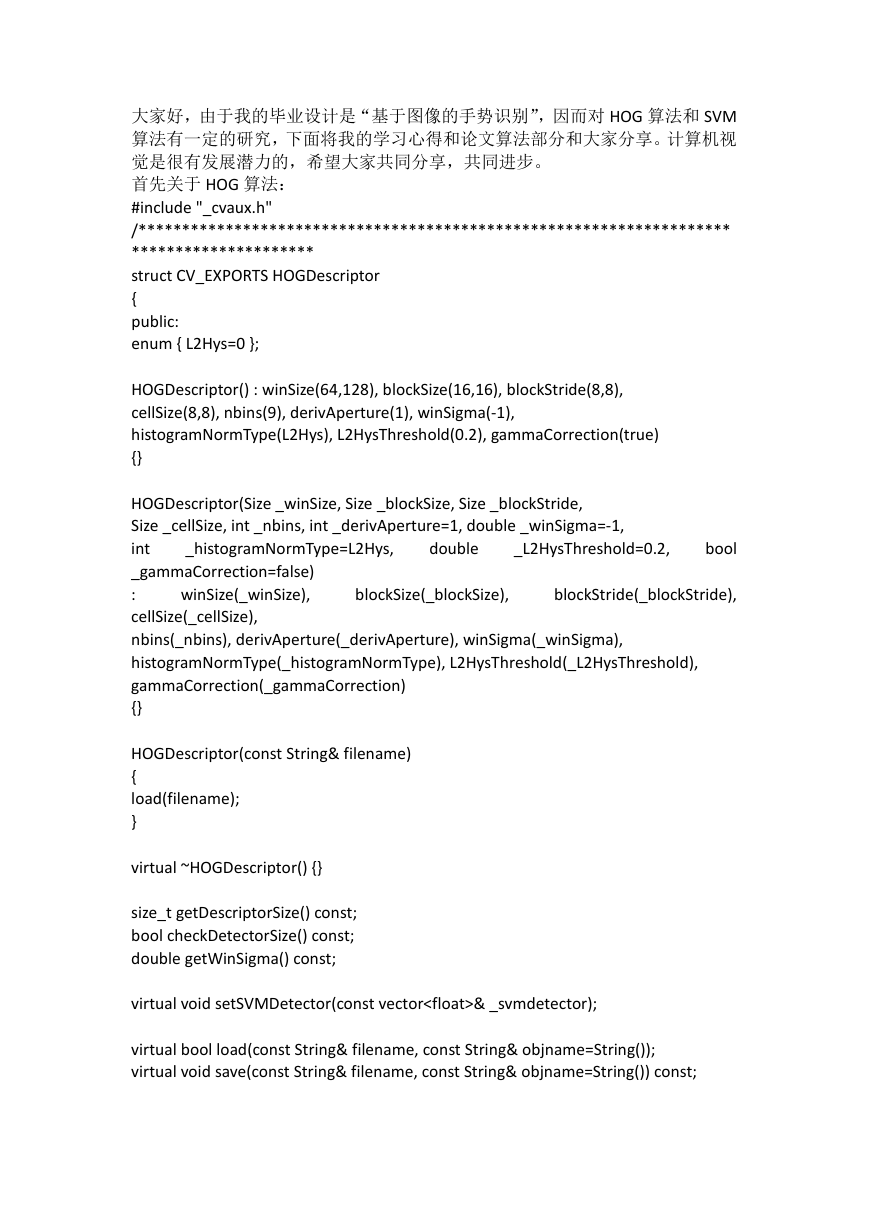

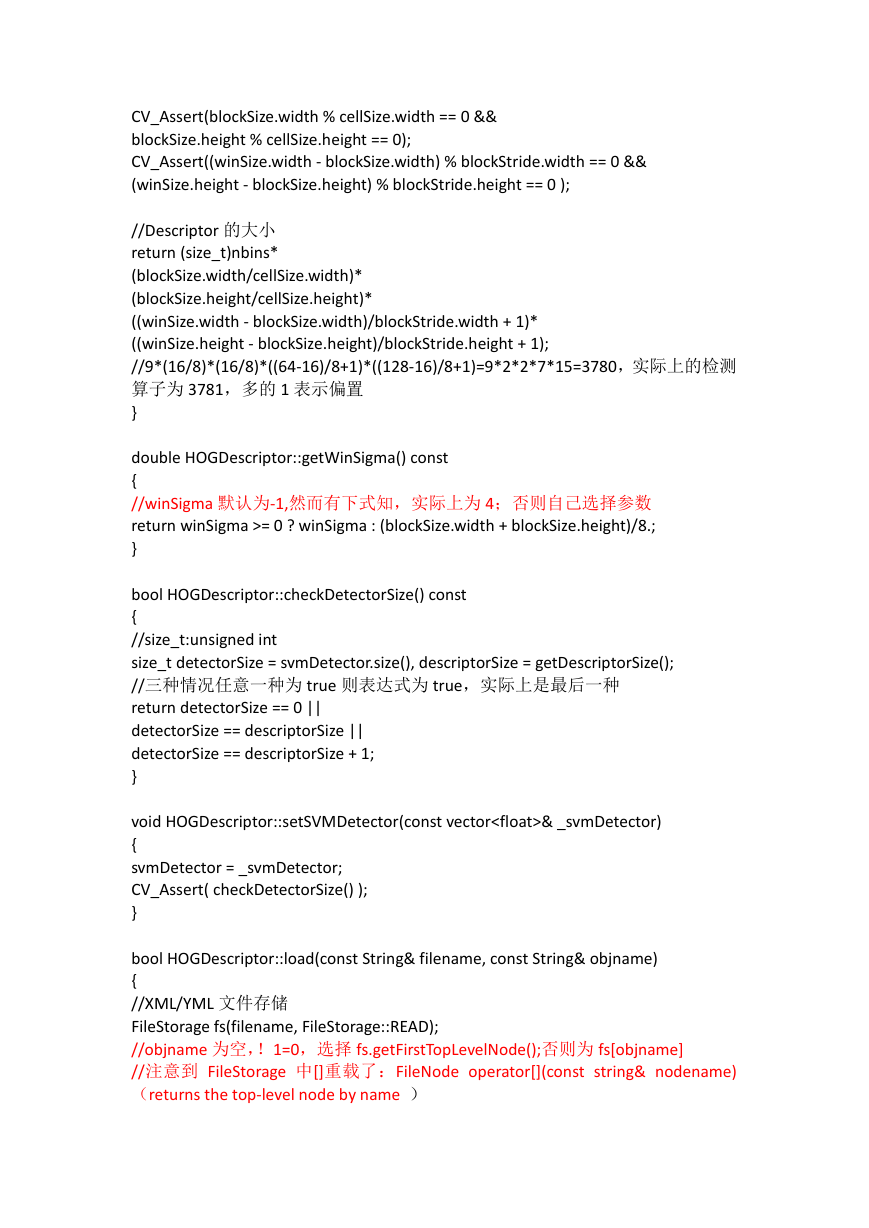
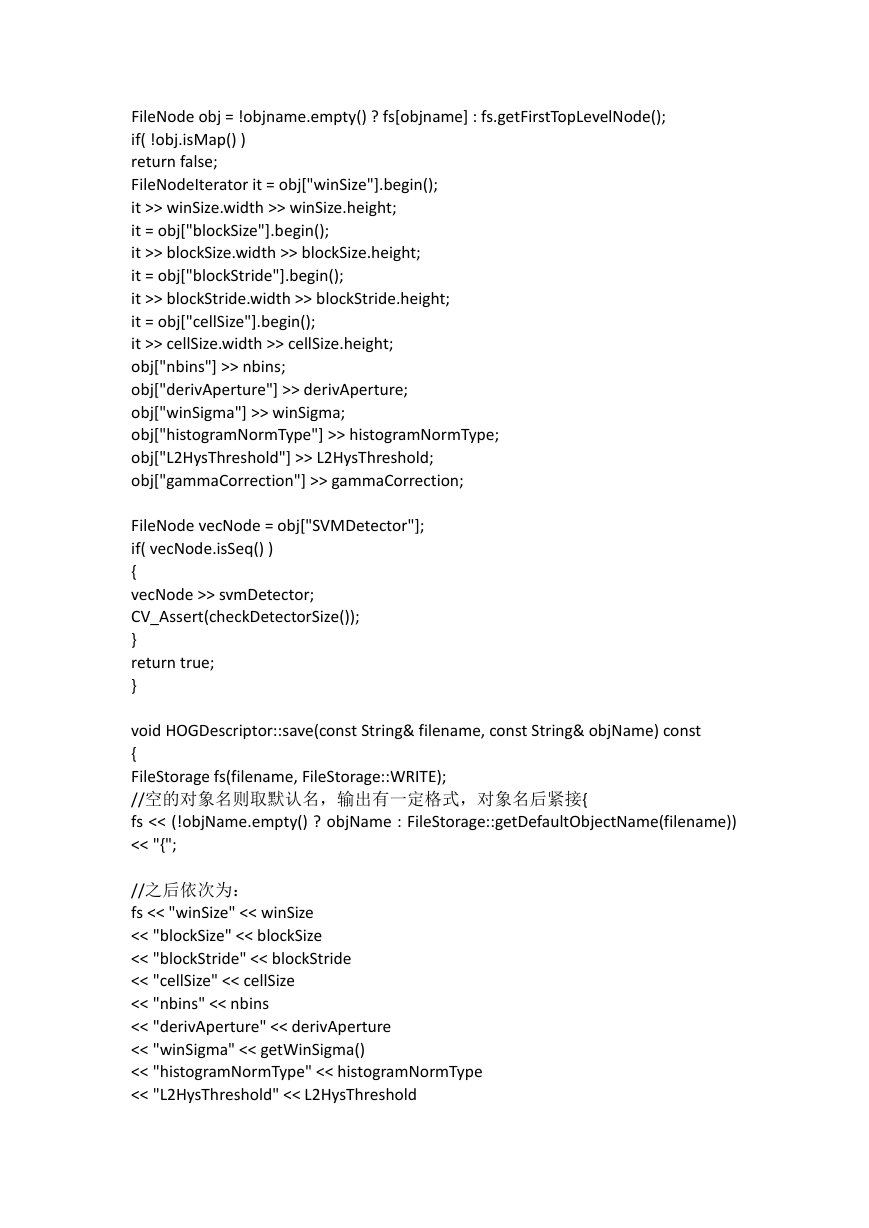
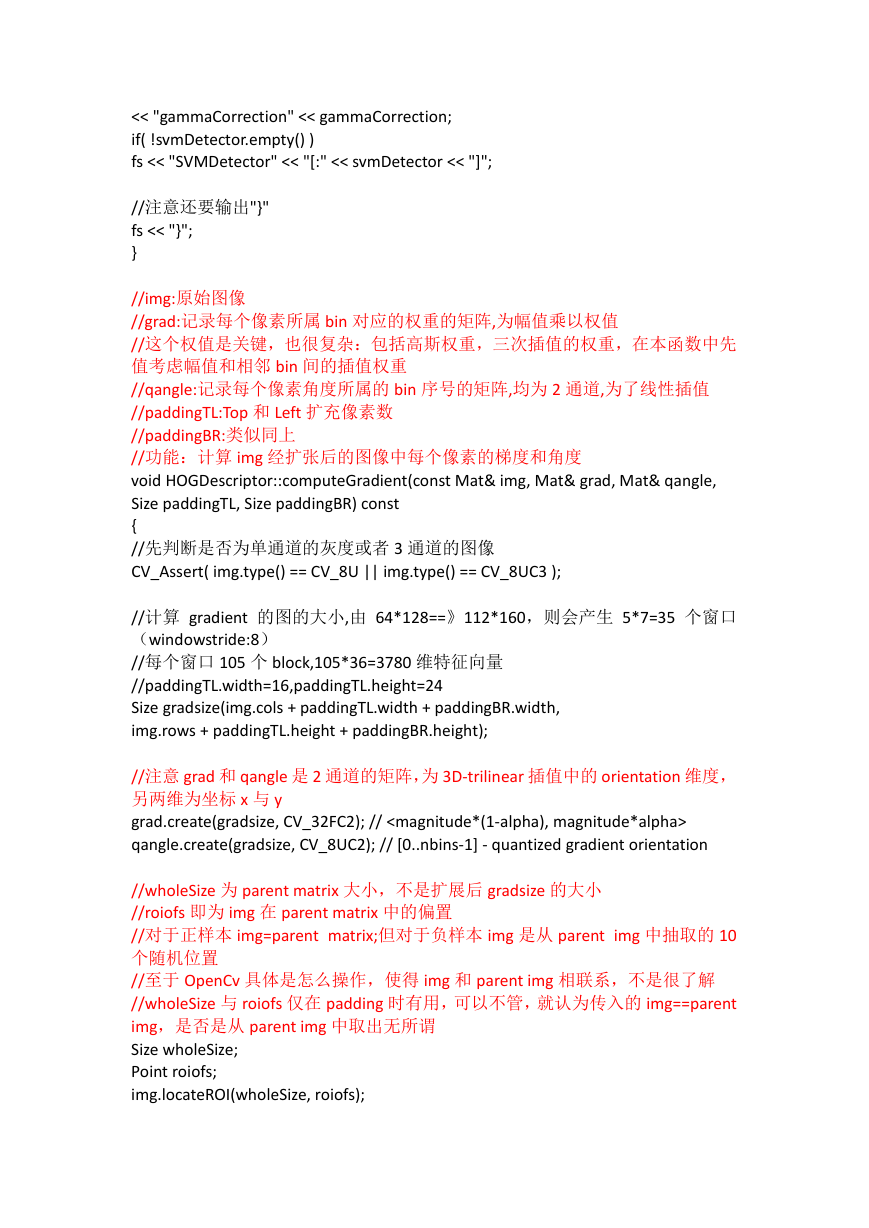
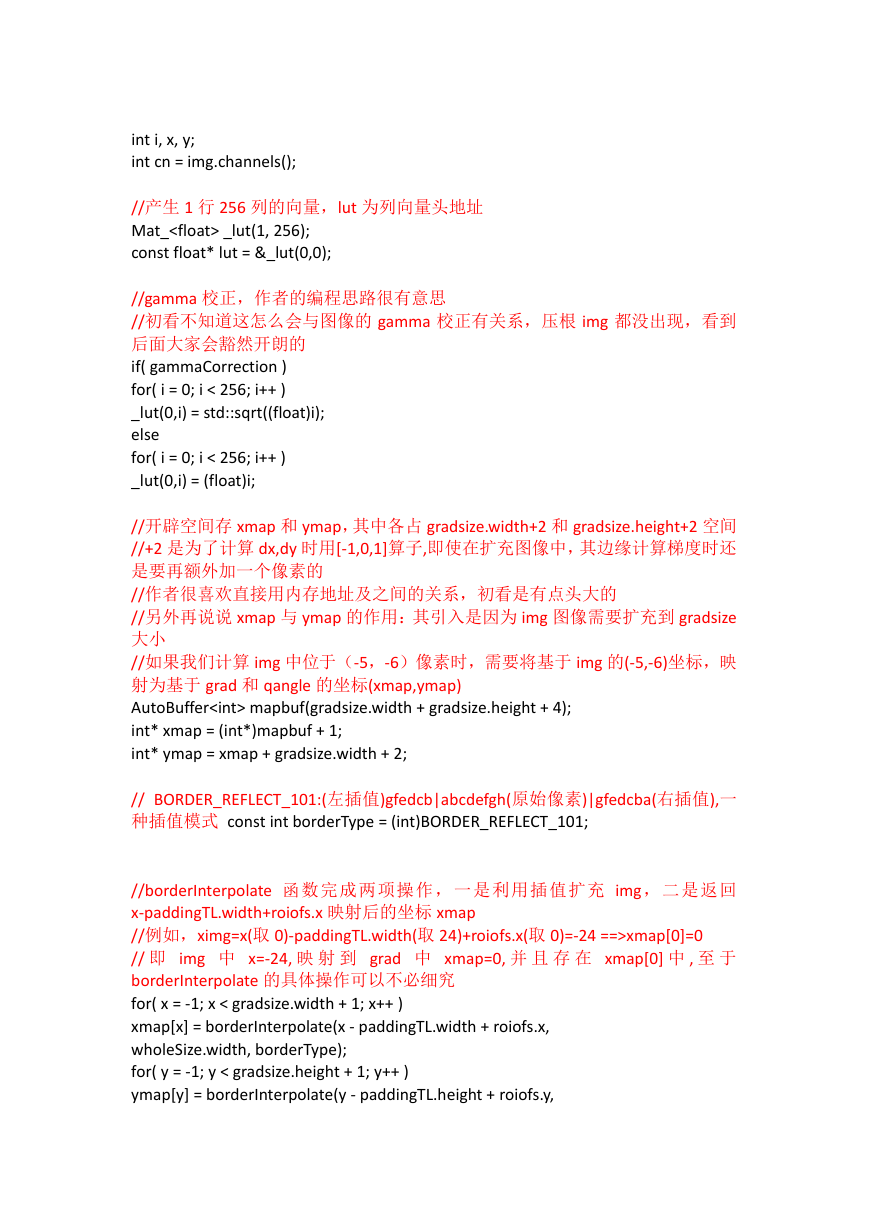
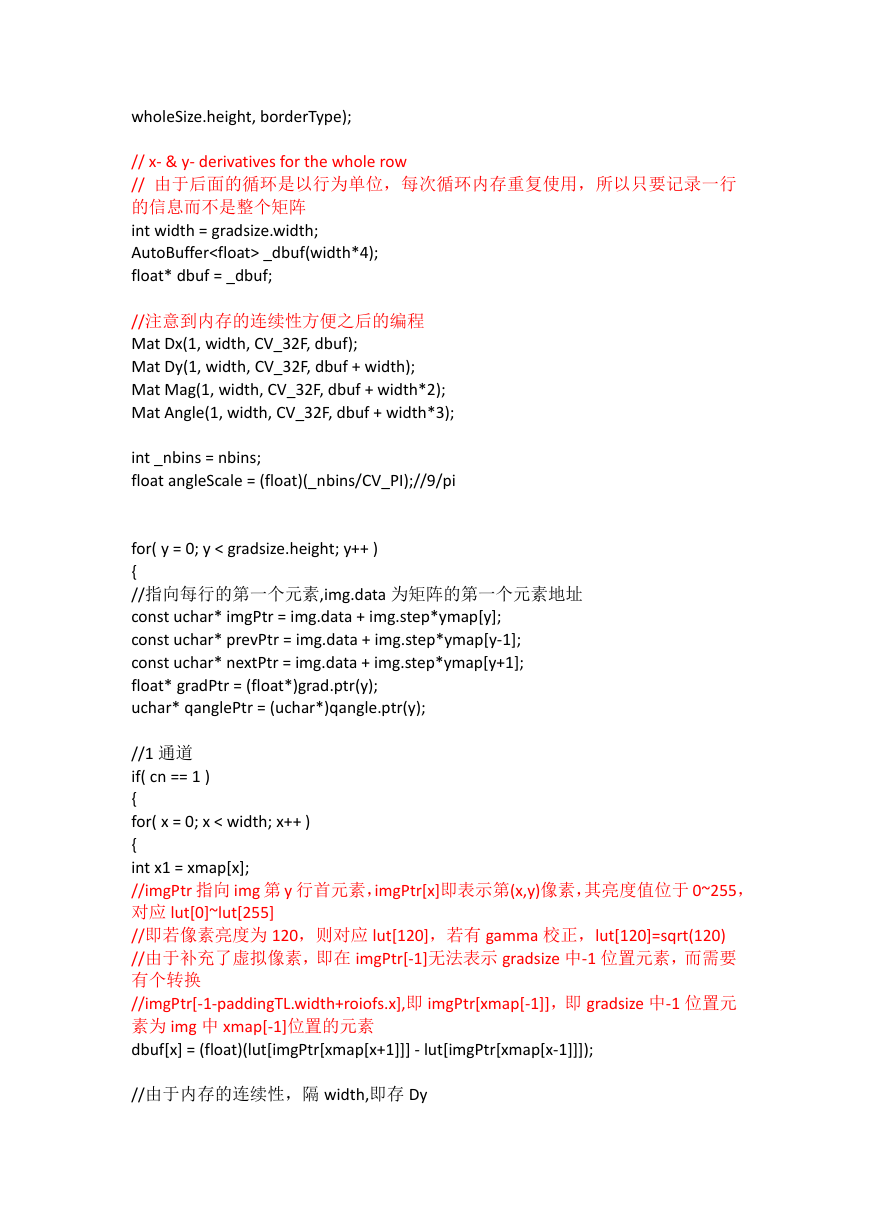
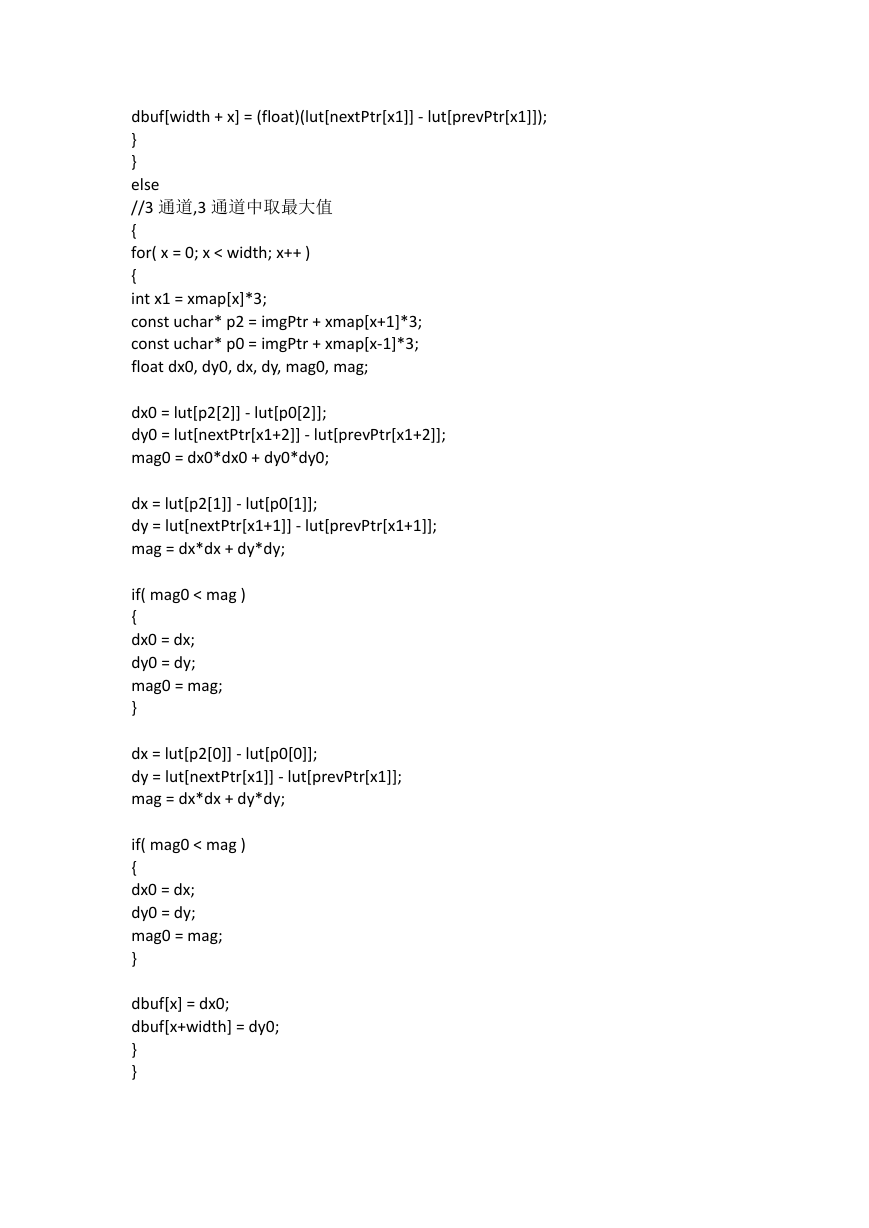








 2023年江西萍乡中考道德与法治真题及答案.doc
2023年江西萍乡中考道德与法治真题及答案.doc 2012年重庆南川中考生物真题及答案.doc
2012年重庆南川中考生物真题及答案.doc 2013年江西师范大学地理学综合及文艺理论基础考研真题.doc
2013年江西师范大学地理学综合及文艺理论基础考研真题.doc 2020年四川甘孜小升初语文真题及答案I卷.doc
2020年四川甘孜小升初语文真题及答案I卷.doc 2020年注册岩土工程师专业基础考试真题及答案.doc
2020年注册岩土工程师专业基础考试真题及答案.doc 2023-2024学年福建省厦门市九年级上学期数学月考试题及答案.doc
2023-2024学年福建省厦门市九年级上学期数学月考试题及答案.doc 2021-2022学年辽宁省沈阳市大东区九年级上学期语文期末试题及答案.doc
2021-2022学年辽宁省沈阳市大东区九年级上学期语文期末试题及答案.doc 2022-2023学年北京东城区初三第一学期物理期末试卷及答案.doc
2022-2023学年北京东城区初三第一学期物理期末试卷及答案.doc 2018上半年江西教师资格初中地理学科知识与教学能力真题及答案.doc
2018上半年江西教师资格初中地理学科知识与教学能力真题及答案.doc 2012年河北国家公务员申论考试真题及答案-省级.doc
2012年河北国家公务员申论考试真题及答案-省级.doc 2020-2021学年江苏省扬州市江都区邵樊片九年级上学期数学第一次质量检测试题及答案.doc
2020-2021学年江苏省扬州市江都区邵樊片九年级上学期数学第一次质量检测试题及答案.doc 2022下半年黑龙江教师资格证中学综合素质真题及答案.doc
2022下半年黑龙江教师资格证中学综合素质真题及答案.doc